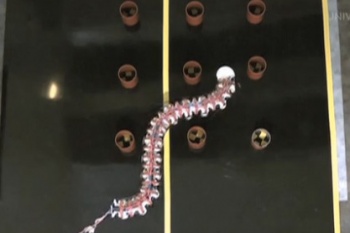Jordan Boyle from the University of Leeds has developed a robotic worm, which is capable of wriggling through obstacles.
 Robo-worm
Robo-worm
Boyle hopes that one day the worm would help in rescue operations in earthquake hit places to search for survivors trapped in the rubble. Boyle has derived inspiration from the nematode worm, Caenorhabditis elegans, and has written the software to imitate its motion. He explained that the nematode worm can step up its wriggling frequency to four times, it is capable of varying its speed and moving in an undulated fashion, all this is achieved with a minute nervous system.
Boyle explained that the nervous system of the nematode worm is made up of 300 neurons; it makes use of around 100 neurons to move in the undulated fashion. Its motion is driven by the feedback received from the stretch sensors present along its body.Boyle has created a robotic worm measuring 2 m in length and 16 cm in width, which moves in the same way as the nematode worm. The robot’s body is broken up into 12 articulated segments; each segment is capable of swinging from one side to another with the help of a geared motor located at the centre. In place of the stretch sensors in the worm, the robot senses each segment’s orientation with respect to its spine and the software uses this data to calculate the robot’s overall motion pattern and orientation. According to Boyle, the robotic worm could be fitted with microphones, infrared cameras and carbon-dioxide sensors, which would help in identifying people trapped in the earthquake rubble. A tough nylon-based plastic was used to construct the snake, instead of using aluminium, which would have cost more. Julie Ryan from the International Rescue Corps commented that the worm would have to be shrunk in size for easy navigation through the rubble.